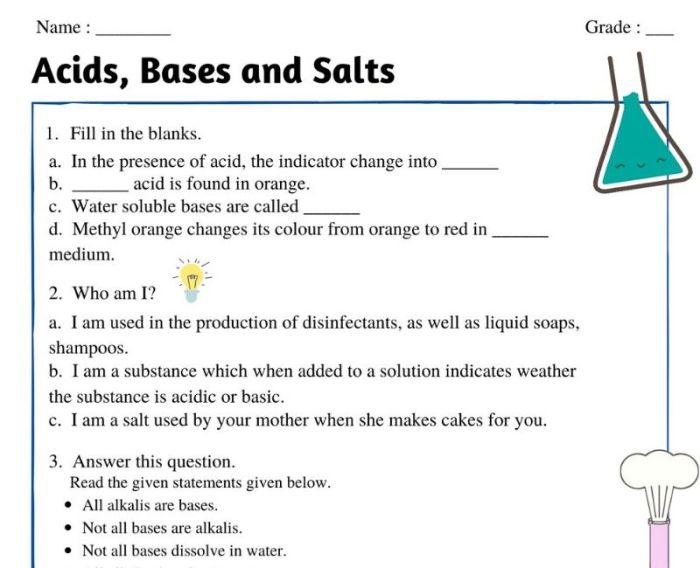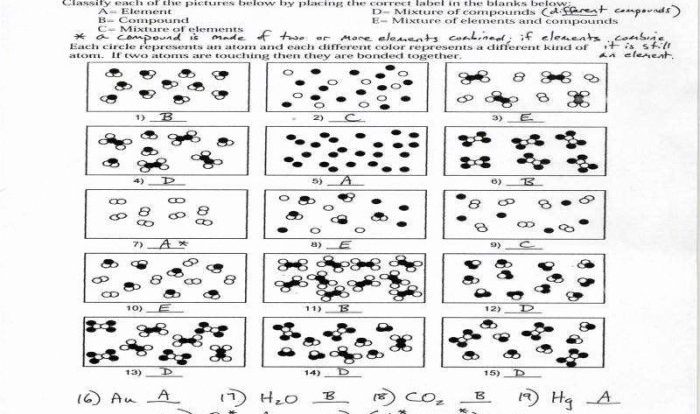Acids bases and salts worksheet with answers pdf – Welcome to our in-depth exploration of acids, bases, and salts, a fundamental topic in chemistry. This comprehensive guide, complete with a downloadable worksheet and detailed answers, is designed to provide a thorough understanding of these essential concepts.
Throughout this guide, we will delve into the definitions, properties, and reactions of acids, bases, and salts. We will also explore the concept of pH, indicators, and titrations, equipping you with a solid foundation in this crucial area of chemistry.
Acids, Bases, and Salts: Definitions and Properties

Acids, bases, and salts are fundamental chemical compounds that play vital roles in numerous chemical reactions. Understanding their properties and behavior is crucial in various scientific fields.
Definitions, Acids bases and salts worksheet with answers pdf
- Acids: Substances that release hydrogen ions (H+) when dissolved in water. They are typically sour in taste and corrosive to metals.
- Bases: Substances that release hydroxide ions (OH-) when dissolved in water. They are often bitter in taste and slippery to the touch.
- Salts: Ionic compounds formed by the reaction of an acid with a base. They are typically crystalline solids and are neither acidic nor basic in aqueous solutions.
Chemical Properties
- Acids: React with metals to produce hydrogen gas, turn litmus paper red, and have a pH less than 7.
- Bases: React with acids to form salts and water, turn litmus paper blue, and have a pH greater than 7.
- Salts: Generally do not react with acids or bases, do not conduct electricity in water, and have a pH of 7.
Examples
- Acids: Hydrochloric acid (HCl), sulfuric acid (H2SO4), acetic acid (CH3COOH)
- Bases: Sodium hydroxide (NaOH), potassium hydroxide (KOH), ammonia (NH3)
- Salts: Sodium chloride (NaCl), potassium nitrate (KNO3), calcium carbonate (CaCO3)
Acids and Bases Reactions
Acids and bases undergo chemical reactions known as neutralization reactions, which result in the formation of a salt and water.
Neutralization Reaction
The general equation for a neutralization reaction is:
Acid + Base → Salt + Water
For example:
HCl + NaOH → NaCl + H2O
Types of Reactions
- Strong acid + Strong base: Complete neutralization, resulting in a neutral solution (pH = 7).
- Weak acid + Strong base: Partial neutralization, resulting in a basic solution (pH > 7).
- Strong acid + Weak base: Partial neutralization, resulting in an acidic solution (pH< 7).
pH and Indicators
pH is a measure of the acidity or alkalinity of a solution, ranging from 0 to 14. A pH of 7 indicates a neutral solution, while values below 7 indicate acidic solutions and values above 7 indicate basic solutions.
Indicators
Indicators are substances that change color depending on the pH of the solution. They are used to visually determine the acidity or alkalinity of a solution.
Common indicators include:
- Litmus: Turns red in acidic solutions and blue in basic solutions.
- Phenolphthalein: Turns colorless in acidic solutions and pink in basic solutions.
- Methyl orange: Turns red in acidic solutions and yellow in basic solutions.
Titrations
Titration is a technique used to determine the concentration of an unknown solution by reacting it with a solution of known concentration.
Steps Involved
- Prepare a solution of known concentration (titrant).
- Measure a known volume of the unknown solution.
- Gradually add the titrant to the unknown solution while monitoring the pH.
- Record the volume of titrant added when the endpoint is reached (usually indicated by a color change of the indicator).
Calculations
The concentration of the unknown solution can be calculated using the following formula:
M1V1 = M2V2
Where:
- M1 = Concentration of the titrant
- V1 = Volume of titrant added
- M2 = Concentration of the unknown solution
- V2 = Volume of the unknown solution
Popular Questions: Acids Bases And Salts Worksheet With Answers Pdf
What is the difference between an acid and a base?
An acid is a substance that donates protons (H+ ions), while a base is a substance that accepts protons.
What is the pH scale?
The pH scale is a measure of the acidity or basicity of a solution. It ranges from 0 to 14, with 0 being the most acidic and 14 being the most basic.
What is a titration?
A titration is a laboratory technique used to determine the concentration of an unknown solution by reacting it with a solution of known concentration.
